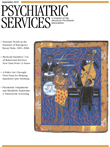Screening for Personality Disorders Among Chinese Prison Inmates
To the Editor: Although only about one-third of the world's inmates live in Western countries, 99% of available data from prison surveys are derived from Western populations (
1 ). Such disparity underscores the need for greater forensic psychiatric research in non-Western populations.
We surveyed 2,961 inmates of five prisons in South China. Seventy-four percent (N=2,189) were men, and the mean±SD age was 30.0±9.9. We used the Personality Diagnostic Questionnaire–4+ (PDQ), the reliability and validity of which have been thoroughly confirmed in Chinese populations (
1 ). Written informed consent was obtained. Data analyses were conducted with SPSS, version 13.0. Group differences were examined with t tests or Mann-Whitney U tests, depending on the nature of the data. Using a cutoff score of 4 or 5, depending on the personality disorder, we found rates of personality disorders ranging from 8% (N=240) to 67% (N=1,981). Borderline personality disorder and antisocial personality disorder were most common—52% (N=1,552) and 67% (N=1,981), respectively.
Fazel and Danesh (
2 ) systematically reviewed 62 studies on the prevalence of major psychiatric disorders among delinquents and found that approximately 65% (N=1,925) had a personality disorder, of which antisocial personality disorder was most common (47%, N=1,392) (
1 ). One possible explanation for the higher prevalence of antisocial personality disorder in our study (67%) may be the poor economic status and low level of education of Chinese inmates. These factors have been linked to personality formation. Another explanation may be related to the large proportion of male inmates in our study. Rates of antisocial personality disorder were higher among male inmates than among female inmates in our sample (72% compared with 53%). The larger proportion of males resulted in a higher rate of antisocial personality disorder and higher average scores for the PDQ antisocial subtype.
Among the 2,961 inmates, 42% (N=1,235) were violent offenders. We found that inmates with a history of violent behavior scored higher than nonviolent inmates on PDQ scales for antisocial, borderline, schizotypal, and depressive personality disorder. [A table comparing scores of inmate subgroups is available as an online supplement to this letter at
ps.psychiatryonline.org .] These findings are consistent with those of a previous study, which found that antisocial and borderline personality disorders among men were correlated with violent conduct (
3 ). Furthermore, the presence of antisocial personality traits among inmates with a history of violence has been consistently associated with an increased likelihood of violent reoffending (
4 ). In a study of female offenders by Putkonen and colleagues (
5 ), 81% of those who committed repeat offenses had a personality disorder diagnosis. In our sample, repeat offenders had significantly higher scores than first offenders on antisocial, depressive, and paranoid personality disorder scales (see online table). Thus personality disorder may have considerable predictive validity.
A prison sentence should offer inmates an opportunity to receive psychiatric assessment and treatment that they may not have had access to outside prison. Furthermore, assessment and treatment may help prevent repeat offenses. Sadly, because of a lack of resources, this opportunity is often unavailable, and providing it remains a challenge for the Chinese government.

